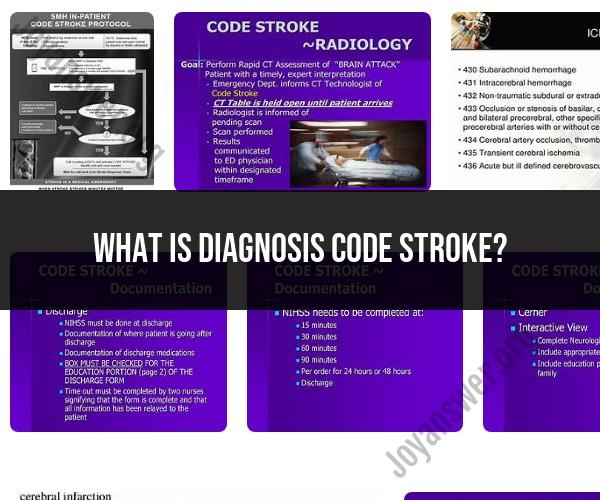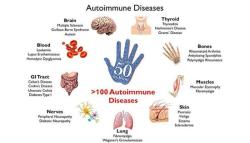What is diagnosis code stroke?
In the International Classification of Diseases, Tenth Revision (ICD-10), stroke is classified using specific diagnosis codes depending on the type and location of the stroke. The most common diagnosis codes for strokes are as follows:
Ischemic Stroke (Cerebral Infarction):
- I63.0 - Cerebral infarction due to thrombosis of precerebral arteries
- I63.1 - Cerebral infarction due to embolism of precerebral arteries
- I63.2 - Cerebral infarction due to unspecified occlusion or stenosis of precerebral arteries
- I63.3 - Cerebral infarction due to thrombosis of cerebral arteries
- I63.4 - Cerebral infarction due to embolism of cerebral arteries
- I63.5 - Cerebral infarction due to unspecified occlusion or stenosis of cerebral arteries
Hemorrhagic Stroke:
- I61.0 - Intracerebral hemorrhage in hemisphere, subcortical
- I61.1 - Intracerebral hemorrhage in hemisphere, cortical
- I61.2 - Intracerebral hemorrhage in hemisphere, unspecified
- I61.3 - Intracerebral hemorrhage in brainstem
- I61.4 - Intracerebral hemorrhage in cerebellum
- I61.5 - Intracerebral hemorrhage in brainstem and cerebellum
- I61.6 - Intracerebral hemorrhage, intraventricular
- I61.8 - Other intracerebral hemorrhage
- I61.9 - Intracerebral hemorrhage, unspecified
Transient Ischemic Attack (TIA):
- G45.0 - Carotid artery syndrome (hemispheric)
- G45.1 - Vertebro-basilar artery syndrome (brainstem)
- G45.2 - Multiple and bilateral precerebral artery syndromes
- G45.8 - Other transient cerebral ischemic attacks and related syndromes
- G45.9 - Transient cerebral ischemic attack, unspecified
It's important to note that these are just a few examples of ICD-10 codes related to strokes. The specific code used by a healthcare provider will depend on the patient's condition, symptoms, and diagnostic findings. Proper coding is essential for medical records, billing, and insurance purposes to ensure accurate documentation of the patient's health. If you or someone you know has experienced a stroke, it's crucial to consult with a healthcare professional for proper diagnosis and treatment.
Diagnosis Code for Stroke: Understanding Medical Coding
Medical coding is the process of translating medical diagnoses and procedures into standardized codes. These codes are used by healthcare providers to communicate with insurance companies and other payers. The most widely used medical coding system in the United States is the International Classification of Diseases, Tenth Revision, Clinical Modification (ICD-10-CM).
The ICD-10-CM code for stroke is I60-I69. This code range includes all types of stroke, both ischemic and hemorrhagic. Ischemic stroke is the most common type of stroke and occurs when a blood clot blocks a blood vessel leading to the brain. Hemorrhagic stroke occurs when a blood vessel in the brain ruptures.
Within the I60-I69 code range, there are more specific codes for different types of stroke and the location of the stroke in the brain. For example, the code for ischemic stroke in the middle cerebral artery is I63.512.
Deciphering Stroke Diagnosis: ICD-10 Code Insights
The ICD-10 code for stroke can provide valuable insights into the patient's diagnosis. For example, the code can tell the healthcare provider the type of stroke, the severity of the stroke, and the location of the stroke in the brain. This information can be used to develop a treatment plan and to assess the patient's risk of complications.
Healthcare providers can also use the ICD-10 code for stroke to track trends in stroke incidence and outcomes. This information can be used to develop public health interventions to prevent stroke and improve the care of stroke patients.
Stroke ICD-10 Code: Documenting Medical Conditions
The ICD-10 code for stroke is used by healthcare providers to document the patient's diagnosis in the medical record. This information is used to communicate the patient's diagnosis to other healthcare providers and to insurance companies. The ICD-10 code is also used to track trends in stroke incidence and outcomes.
It is important for healthcare providers to use the correct ICD-10 code for stroke. Using the wrong code can lead to delays in treatment and can make it difficult to track trends in stroke incidence and outcomes.
Here are some examples of how the ICD-10 code for stroke can be used to document medical conditions:
- A patient is admitted to the hospital with a diagnosis of ischemic stroke in the middle cerebral artery. The healthcare provider would use the ICD-10 code I63.512 to document the patient's diagnosis in the medical record.
- A patient is discharged from the hospital after recovering from a hemorrhagic stroke in the cerebellum. The healthcare provider would use the ICD-10 code I61.9 to document the patient's diagnosis in the medical record.
- A healthcare provider is tracking the number of stroke cases in their community. They would use the ICD-10 code range I60-I69 to identify all stroke cases.
The ICD-10 code for stroke is an important tool for healthcare providers to communicate with each other and to track trends in stroke incidence and outcomes. By using the correct ICD-10 code, healthcare providers can help to ensure that stroke patients receive the best possible care.













